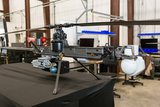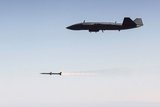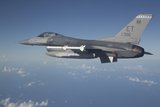US Navy’s next-generation sensor for Super Hornets achieves Initial Operating Capability
The USN has announced IOC for the F/A-18 E/F IRST Block II system. (Photo: USN)
The USN has announced Initial Operational Capability (IOC) for the Boeing F/A-18 E/F Super Hornet IRST Block II system, providing the fleet with an enhanced capability to search, detect and track airborne targets at long range.
IRST Block II adds an improved sensor, upgraded processor and additional software with a first deployment planned in 2025.
The system increases situational awareness by supplementing air-to-air detection and track capabilities. It also acts as a complementary sensor to the aircraft’s AN/APG-79 fire control radar in a heavy electronic attack or radar-denied environment.
Related Articles
Paris Air Show: Sharper sting for Boeing's Super Hornet
IRST Block II pod flies on F/A-18 Super Hornet
US Navy F/A-18s return to the Hornets' nest for Block III upgrades
At the core of the system is Lockheed Martin’s IRST21, a long-wave infrared search-and-track sensor that passively detects airborne targets beyond visual range.
The system achieved IOC after completing Initial Operational Test and Evaluation with Air Test and Evaluation Squadron (VX) 9.
The F/A-18 and EA-18G Program Office (PMA-265) partnered with military, civilian and contractor personnel from VX-31 and VX-23 to leverage a combination of operational and developmental test facilities and assets throughout 2024.
Rear Adm John Lemmon, programme executive officer for Tactical Aircraft Programs, described IOC as “an important milestone in our overarching efforts to deliver advanced integrated warfighting capability to the fleet”.
“IRST provides data for our aircrew to improve reaction time and survivability while remaining unaffected by radio frequency jamming,” Adm Lemmon said.
Related Programmes in Defence Insight
Related Equipment in Defence Insight
More from Air Warfare
-
![Anduril UK and GKN Aerospace collaborate on British Army ACP bid]()
Anduril UK and GKN Aerospace collaborate on British Army ACP bid
The pair will submit their demonstrator concept for Project Nyx, a development project for the British Army’s Land Autonomous Collaborative Platform.
-
![US Army command’s Picatinny CLIK common lethal drone interface makes progress]()
US Army command’s Picatinny CLIK common lethal drone interface makes progress
The Picatinny Common Lethality Integration Kit is designed to overcome the issue of unique integration methods between lethal payloads and drones as well as avoiding problematic acquisition conditions created by vendor lock.
-
![Australia invests extra A$1.4 billion in MQ-28A Ghost Bat after successful missile fire test]()
Australia invests extra A$1.4 billion in MQ-28A Ghost Bat after successful missile fire test
The investment includes new contracts for six MQ-28A Ghost Bat aircraft, as well as provisional funds to invest in the development of a Block 3 prototype.
-
![US approves potential $4.7 billion missile and air defence system sales to Denmark and Italy]()
US approves potential $4.7 billion missile and air defence system sales to Denmark and Italy
Italy could field the JASSM-ER for its combat aircraft including the F-35, while Denmark has been approved for AMRAAM and an Integrated Battle Command system procurement.
-
![Northrop Grumman to fly new Project Talon CCA by late 2026]()
Northrop Grumman to fly new Project Talon CCA by late 2026
The newly unveiled collaborative combat aircraft looks to strike a balance between capability and cost-effectiveness, according to the company.
-
![MBDA and Lockheed move closer to F-35A Meteor flight tests]()
MBDA and Lockheed move closer to F-35A Meteor flight tests
Following the completion of successful ground tests, one more exercise remains before flight testing can begin.























